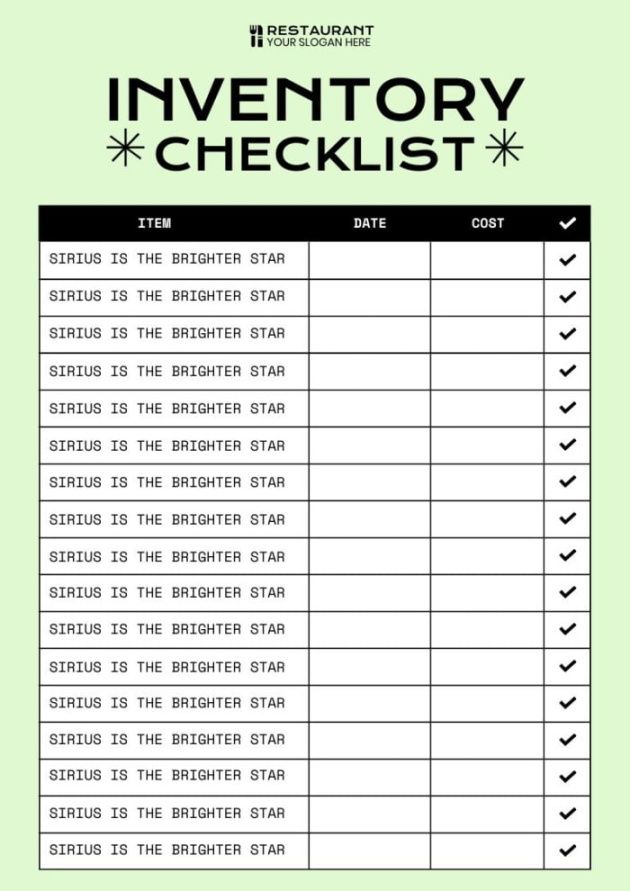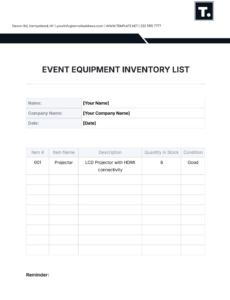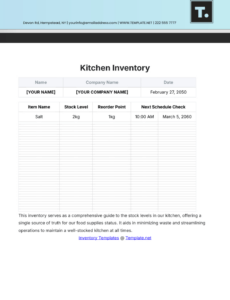Personalize and download this simple modern restaurant appliances inventory checklist template kitchen equipment inventory list template example -Ever feel like you’re reinventing the wheel every time you need to organize information? Whether you’re planning a grocery list, managing responsibilities for work, or creating a packing checklist for your future travel plans, beginning without a guide can be a huge drain on effort. That’s where a valuable aid called a formatted task planner comes in. It’s a ready-to-use layout that provides a base structure for structuring different plans, reducing wasted effort and effort.
Who wants to spend extra effort to create a organized outline starting fresh every time? That’s where a pre-built structured format becomes your best friend. Consider it a ready-made guide to organization, easily modified for various purposes. Say goodbye to looking at a unstructured list, feeling lost in setup. These formats provide a ready-made structure, reducing effort and cognitive load so you can prioritize actually getting things done.
Through this discussion, we’ll explore the valuable tool of checklist creation, discovering ways they streamline different parts of your personal and professional tasks. We’ll analyze the multiple formats of templates available and feature sources offering top templates. Interested in say goodbye to formatting struggles and harness structured planning? Time to begin.
The upsides of using a pre-made checklist are numerous and wide-ranging. Beyond the clear productivity boost, they also support enhanced planning, reduced errors, and greater efficiency. Imagine avoiding concerns over whether you’ve missed an important detail in a workflow or missed a key element on your shopping list. With a well-crafted template, those concerns become a non-issue.
A frequent purpose for structured formats is designing basic planners. These can be as minimal as jotting down a few errands to accomplish or as complex as a daily planner with timed sections and task rankings. A thoughtfully designed daily planner can significantly boost efficiency by offering a detailed overview for the day. Think of categories such as “Work”, Individual matters, and Routine tasks, each with its own organized outline.
Beyond to-do lists, structured formats are highly effective in project management. Whether arranging an event, starting a business venture, or renovating your home, a structured task planner can help you divide the work into smaller action steps, delegate duties, define timelines, and follow up on completion. This makes sure that nothing falls through the cracks and that the task remains well-managed.
List templates are also incredibly versatile. They can be applied to a wide range of purposes, from managing everyday responsibilities to structuring business strategies. The key is to select a structured format that suits your personal requirements and then modify it to match your unique style. There are formatted checklists built for project management, target tracking, grocery shopping, travel packing, and countless other uses. The possibilities are endless.
Finally, a well-organized checklist can serve as a valuable learning tool. By reviewing structured formats, you can understand effective strategies for organizing information and structuring lists effectively. This can support your growth in your own skills and enhance your productivity. No matter if you’re a student, a businessperson, or simply an individual looking for better structure, structured formats are an important asset.
The beauty of structured checklists lies in their flexibility. There’s a checklist for virtually any project or responsibility you can think of. From simple to-do lists to advanced workflow planners, the ways to use them are limitless. Learning about the different types of structured formats can help you choose the most suitable choice for your individual preferences.
Task Checklists: These are arguably the most basic and widely used type of formatted organizer. They usually feature columns for task description, completion timeframe, urgency status, and finished confirmation. They’re perfect for keeping track of responsibilities, monitoring key objectives, or even listing purchase requirements.
In case you need something more specialized, try searching for structured formats related to your field or duties. For example, if you oversee projects, you might find “project management checklist template” or a task scheduling tool. Similarly, for educators, you might search for “lesson plan template” or a student assessment format. The greater the detail you include, the better the possibility you are to come across a pre-built organizer that matches exactly your preferences.
**Workflow Organizers:** These are advanced formats designed for managing larger, more complex projects. They often feature interrelated steps, resource allocation, Gantt charts, and milestone monitoring. They’re highly important for ensuring smooth execution and making sure that deadlines are met.
So, next time you see yourself dealing with a challenging project or struggling with a large amount of data, recall the effectiveness of the list template. It might just be the secret weapon you need to beat difficulties and reach your goals.



